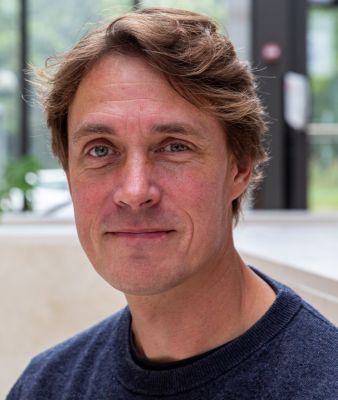Curriculum Vitae Anders Østergaard Madsen
Associate Professor, Cand. Scient., Ph.D.
e-mail: a.madsen@sund.ku.dk,
Researcher ID: B-4760-2015 ORCID: 0000-0001-5422-8076
google scholar:
https://scholar.google.com/citations?hl=en&user=rQQuoAkAAAAJ
Work Address: Department of Pharmacy, University of Copenhagen,
Universitetsparken 2. DK-2100 Copenhagen, Denmark,
Born October 2, 1974, Denmark. In a relationship, 5 Children.
Education Ph.D. in Chemistry from the University of Copenhagen and European Synchrotron
Radiation Facility.
Research focus: Structure-property relationships in solid state molecular crystals. Dynamics
of crystals. Computer modelling. Crystallographic method development. Machine learning in
crystallography.
Grants (PI) 2008 - 2020 ~ 11.000.000 DKK from Danish research councils, Carlsberg foundation,
Villlum foundation, Lundbeck foundation.
Publications
Number of peer-reviewed publications 55
Number of citations 6900+ (google scholar)
H-index 24 (google scholar)
Invited oral presentations 22
Invited popular oral presentations 4
Awards 2010: Young Elite Researcher's Award of the Danish Council for Independent Research
(200.000 DKK) 2009: Steen & Ingrid Ahrlands Award of the Royal Physiographical Society, Lund,
Sweden (50.000 SEK). 2007: Young Scientist Award of the International Union of Crystallography
(1000 USD).
Refereeing Nature, Nature Chemistry, Acta Crystallographica section A, B and C., IUCr-J,
Journal of Physical Chemistry, Journal of Applied Crystallography, Zeitschrift für Kristallographie,
Journal of Organometallic Chemistry, Structure and Bonding, Scientific Reports, European
Journal of Pharmaceutics. Review for the Swiss and Polish National Science Foundations.
Editing Associate editor of IUCr Newsletter
Boards etc.
Member of the executive committee of the Danish Chemical Society since 2017.
Chair of the Danish National Committee for Crystallography 2018. Secretary of this Committee
2012-2018. Member of Danscatt board (www.danscatt.dk).
Danish delegate at the European Crystallographic Association General Assembly, 2012, 2013,
2015, 2016, 2018. Delegate at the International Union of Crystallography General Assembly
2014, 2021.
Teaching, education of scientists
Materials Chemistry. Bachelor level course in materials chemistry (7.5 ECTS). Course
responsible. 2011 – 2016. MatIntro. Introductory calculus course (7.5 ECTS). 2005 - 2007,
2010. Crystallography. Small molecule and macromolecule crystallography course. (7.5
ECTS). 2005 – 2017. Advanced Crystallography (7.5 ECTS). Masters level course in
crystallography. 2013, 2015, 2016. Pharmaceutical Modeling (7.5 ECTS). Masters course in
modeling and programming. Chemical Principles (7.5 ECTS). 1st year general chemistry course.
PhD (co-) supervisor of 4 students. BSc and MSc- supervision 5 students. Supervisor of 6 post
docs. Public outreach: Numerous lectures on different aspects of crystallography and drugs for
high-school students and high-school teachers.
Lecture 25: Anders Madsen
Dynamic Quantum Crystallography: Thermal motion in crystallography seen through a quantum-mechanical looking glass
Prof. Anders Madsen
Department of Pharmacy, University of Copenhagen,
Universitetsparken 2. DK-2100 Copenhagen, Denmark,
e-mail: a.madsen@sund.ku.dk
A plethora of important bulk solid state properties depend on crystal vibrational properties. The atomic and molecular motion determine the vibrational entropy of crystals, and are therefore crucial for understanding stabilities and phase changes. Mechanical properties, such as the elastic moduli of the crystal, are also intrinsically linked to the crystal lattice dynamics.
Information on the correlation of atomic motion is lost in the standard elastic scattering experiment. However, the atomic motion gives rise to changes in the diffraction intensities, which are taken into account in the form of the Debye-Waller factor. The temporal and spatial average of the atomic fluctuations – mean square displacements - can therefore be retrieved from a diffraction measurement, and in our work this information has been combined with lattice-dynamical models derived from periodic DFT calculations (Hoser & Madsen, 2016, 2017 Acta Cryst. A.). In this approach, the amplitudes of the acoustic and lowest-frequency optical phonons are refined against the diffraction intensities.
Despite the rather simple lattice dynamical model, these Normal Mode Refinements (NoMoRe) captures essential information about the crystal dynamics from the experiments.
The atomic mean square displacements obtained by fitting the normal modes against the diffraction intensities compare well with the displacements obtained from standard crystallographic models, and additionally the hydrogen atom anisotropic displacements compare well with independent information from neutron diffraction experiments.
In this presentation, I will present our approach and discuss cases where we have used the model to calculate heat capacities as well as to study the thermodynamics of enantiotropic polymorphic systems and phase transitions.


